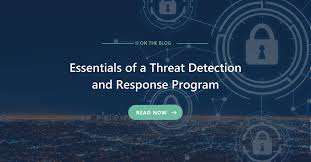What is Threat Detection and Response (TDR)?
Updated on June 16, 2023, by OpenEDR

With the digital advancements in society, all businesses, organizations, governments, and corporations rely on computerized systems to manage their day-to-day activities. And because of this digital era, there is an increased number of cyberattacks. In the wake of growing cyberattacks, there is an advancement of technologies; unfortunately, cyberpunks also imply a parallel shift to the trends and find new ways of data breaches, hacks, and more. Numerous threat detection and response tools were launched to safeguard people’s systems, but hackers were nowhere back. These tools need to evolve to stop the issues they create.
In this article, we will understand the top trends of cybersecurity that you need to learn.

What is a cyberattack? – Threat Detection and Response (TDR)
A cyber attack is an onslaught launched by cybercriminals using one or more computers against single or multiple computers or networks. It harms the system by maliciously disabling computers, using a breached computer, and stealing data. There are various methods to launch cyber attacks, including malware, phishing, ransomware denial of service, and other forms. Multiple measures are taken to mitigate these attacks, and even new initiatives are taken, which is helpful for threat detection and response (TDR) security.
Prospective of Artificial Intelligence (AI) for threat detection and response
AI is everywhere, ruling all market segments and bringing tremendous changes in cybersecurity. AI has been used in building face detection, automatic threat detection, natural language processing, and more for threat detection and response. Undoubtedly, it is being used to develop innovative malware and attacks to bypass the latest security protocols in controlling data. But these can do wonders when you are under the influence of cyberattacks.
Penetration testing services for threat detection and response
Penetration testing services can be a game changer for the business’s security system. It simulates cyber attacks to expose vulnerabilities in systems of networks. Companies need to invest in penetration testing this year to detect and address vulnerabilities before cybercriminals can exploit them. Companies can readily identify weaknesses in their security measures with the help of this latest trend. From misconfigured firewalls to outdated software, these penetration services can encourage you and lead to threat detection and response.
Cloud is vulnerable – Threat Detection and Response (TDR) Cyber Security
When leading a massive organization, you must keep security measures in mind. As more and more organizations are established on the cloud, security measures must be continuously monitored and updated to safeguard the data from leaks. Google or Microsoft is well equipped with security, leading to threat detection and response. Still, the user end is a significant source of erroneous errors, malicious software, and phishing attacks. Making your system free from those malicious cyberpunks can be helpful.
Remote working cybersecurity for threat detection and response
The pandemic has forced multiple companies to move to remote working, introducing a new cybersecurity challenge. Workers working remotely are more vulnerable to cyberattacks as they often have less secure networks and devices. A secure VPN, multifactor authentication, and automated patching are all effective ways to keep remote workers protected. So, this is another trend this year that can be helpful for threat detection and response.
Multi-factor authentication for threat detection and response
It is another trend in cybersecurity. Authentication using more than one factor is a security measure that asks users to provide multiple forms of identification before they can access an account. This additional layer of security helps protect against cyberattacks, as attackers must access various pieces of information. Organizations must ensure that all accounts are secured with MFA to reduce the risk of unauthorized access. This automation is increasingly important in cybersecurity. These automated security processes can reduce the time it takes to detect and respond to threats and improve the accuracy of threat detection.
Real-time data monitoring for threat detection and response
Real-time data monitoring is another prevailing trend as a safety standard that enables organizations to detect and react to dubious activity. They must ensure they have adequate measures in place to monitor all data activity, like log monitoring and automated alerts. For every business, this is a must-feature.
Data Breaches for threat detection and response
Data will always be a top concern for businesses worldwide. Digital data is one of every individual or organization’s primary goals for threat detection and response. You have to be careful with the same because any minor flaw or bug in your software is a potential vulnerability for hackers to access personal information. There are numerous strict measures taken.
Final Words! – Threat Detection and Response (TDR) Cyber Security
Multiple ways are used to prevent cyberattacks, but still, numerous organizations are not protected. All networks, endpoint devices, and cloud services must be protected against cyber-attacks since they can be prevented.
As you know, these cyber attacks are still there even after the engineers have taken multiple measures to protect the system. This makes it essential for business organizations to consider a powerful tool for the business and protect all their data from the data threat. Other than this, it is also necessary to keep up with the learning curve in cybersecurity today to become experts for tomorrow.
If you are struggling with the security game, consider getting help from OPEN EDR. It is a free and open-source endpoint detection and response solution. It will help you mitigate cyberattacks with the help of threat detection and response.
Visit their website to learn more https://www.openedr.com.
Related Resources: